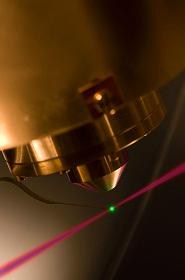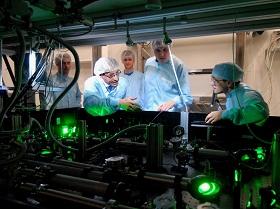Using AI to control energy for indoor agriculture
30 September 2024
Published online 10 October 2010

For Abdallah Azzeer, his long-term goal of turning Saudi Arabia into a regional hub for advanced laser physics starts with studying matter at short, or rather unimaginably short, time scales – racing against the hasty flashes of time lasting mere billionths of a billionth of a second.
To that end, the Saudi physicist is leading a collaborative research program involving King Saud University (KSU), where he works, and the famed Max Planck Institute for Quantum Optics (MPQ) in Germany. "If you want the best outcome from a partnership, you must go to the best," Azzeer says.
Leading the MPQ side is Ferenc Krausz. The Hungarian physicist's Laboratory for Attosecond Physics is credited with expanding our knowledge about the behavior of electrons, through observing and measuring at the most fleeting of time durations, phenomena once deemed the preserve of theoretical physicists.
"The Krausz group at MPQ is the world's leading lab in measuring the attosecond ionization dynamics of atoms and surfaces," says David Velleneuve, programme leader of the joint laboratory for attosecond science at the National Research Council of Canada. "They have a well-deserved history of making the covers of Science and Nature in the past decade."
The latest additions to the group's gallery of science journal covers are a product of the collaboration between MPQ and KSU.
In August, a paper from the MPQ-KSU team made the cover of Nature, an accolade most researchers would covet. The Krausz group, including Azzeer, captured in real-time, for the first time, the movement of valence electrons - those that reside in the outer boundaries of atoms and interact with other atoms in chemical reactions1.
Earlier this summer, the group reported in Science (again making the cover) a phenomenon they dub 'photoemission delay'2. This work continues on from a discovery first elaborated by Einstein at the turn of the twentieth century: the photoelectric effect, which earned Einstein his Nobel Prize in 1921.
The photoelectric effect describes the observation that when photons hit a metal, it excites the electrons of that metal, propelling them to move around, probably beyond their orbital path, and thereby creating a small electric current.
There is no high-level applied research without high-level basic research.
"For a long time the assumption was that there was no lag between the two steps," says Azzeer. "Time between the excitement by photons and the release of electrons was assumed zero."
This assumption was first challenged in the 1950s – though theoretically, not experimentally. The theoretical intuition reckoned there should be a lag before the release of electrons when an atom is struck by energy pulses of photons. To test this theory required technology beyond what was available until now.
Thanks to the Krausz group's research, we now know that photoemission delay exists, not merely in the long-hand equations of theoretical physicists, but as a phenomenon that can be monitored and measured.
"We discovered that the electron seemed to wait, to hesitate, when receiving the energy pulses, for a duration of 21 attoseconds, give or take five attoseconds, before it finally moves" says Azzeer.
A duration of 16 to 26 attoseconds, the range of the delay, is of course a time-scale too extraordinarily short for the rest of us to grasp. Our bounds of familiarity with time measurements are rarely shorter than seconds. A blink of an eye (in the range of milliseconds) is probably the fastest we can go. An attosecond, in contrast, equals 1 x 10-18 second –or a billionth of a billionth of a second. An attosecond is to the second what a second is to the entire age of the Universe.
So what difference does the discovery of such a very short delay make to science that merits the covers of the world's leading science journals? "It is important from a fundamental point of view," Krausz says. "Such a delay may change our understanding of the fundamental interactions between photons and electrons, and between one electron and another inside atoms."
The value of understanding the nature and behavior of electrons cannot be overestimated. Whether it is semiconductors that power computers or the mechanisms that turn cells cancerous, at some fundamental level electron activity is happening.
In addition, the Krausz group's work underlines a time-honored scientific ethic: it is always profitable to science whenever our measurements become so precise that they register a non-zero value for phenomena that would otherwise present us with the opaque zero.
"If you try to observe this delay effect with femtosecond laser pulses, your result will be zero," says Martin Schultze, the lead author of the Science paper. A femtosecond equals a thousand attoseconds. "You will not see any time delay in the femtosecond time-scale because the resolution of the technique is insufficient. Our technique is novel," he adds.

© Max Planck Quantum Optics
The technique may be novel and the research may push forward our basic knowledge about electrons, but MPQ and KSU may still seem odd bedfellows. Why does a Saudi university partner with a basic research lab and not with one focused on, for instance, hydrocarbon applied research, given the Kingdom's vast oil reserves? And what would MPQ gain from such a partnership?
The partnership between MPQ and KSU, in effect since January 2008, should serve both parties well. Scientists and PhD students at the Saudi university will have access to cutting-edge research and technology. In return, the Saudis will foot the bill for some of the increasingly ultra-expensive equipment that advanced laser research demands.
It is not, however, a simple cash-for-access relationship. "The other thing, which I would say is equally important from our perspective, is that you get a constant flow of young people coming along to do work at the lab here," says Schultze. "They will learn what we are doing, and hopefully they will then spread the knowledge that we have to other labs."
This is advantageous to MPQ on more than one account. It makes up for the fact that MPQ is not directly affiliated to a university, the natural source of fresh talent and support in lab work. On the other hand, if the methods and techniques of MPQ are widely adopted, and if more "interesting science" results, more kudos — and more funding — will flow to MPQ, says Schultze.
As more Saudi Arabia-based researchers head to the Max Planck Society, Azzeer is thinking long-term. The aim is not merely to modernize a physics department, he says, but rather to establish a regional center for state-of-the-art laser research in Saudi Arabia that attracts the best talent and provides them with the technology they need. The first shipment of equipment for the future Saudi Arabia centre is nothing but the equipment that the KSU has contributed to MPQ.
Saudi Arabia is far from alone in trying to establish itself as a hotbed for varied types of research. In neighboring Qatar and the United Arab Emirates, similar efforts are afoot — for instance Doha's Qatar National Research Fund and Abu Dhabi's Masdar Institute for Science and Technology.
The MPQ-KSU venture is special for its focus on basic research — quite a rarity in the Arab Gulf states, where most collaborative projects seem geared toward applied research, especially in hydrocarbons.
For the fundamental physicists, the fundamental-versus-applied dichotomy was put to rest. "It is very simple. There is no high-level applied research without high-level basic research," says Krausz.
To illustrate his point, the Hungarian physicist uses an analogy of building pyramids: "You cannot succeed in building a pyramid without first laying the broad base. In science a strong base is created by high-level fundamental research," he says. "And then the tip of the pyramid is the high-tech product, the applied research part."
While building a pyramid may seem like a lengthy endeavor, there is probably another more immediate gain from fundamental research. Industry has a growing appetite for people who can make use of highly sophisticated technology. The best candidates to fill these positions, says Schultze, are those familiar with such technology from their fundamental research training.
The MPQ-KSU is one of as many as 83 'twinning programs' between KSU and domestic and global partners in academia and to a lesser degree in industry, according to the KSU website. The aim is to build strengths in certain emerging fields, such as nanotechnology and data security.
Such partnerships, along with today's ease of instant communications, offer Saudi researchers access to the most up-to-date knowledge in a field without having to permanently relocate to other countries as they had to in the past. "I only travel to monitor experiments, take results, and participate in discussions," says the Saudi physicist. "The rest I do by email."
doi:10.1038/nmiddleeast.2010.210
Stay connected: